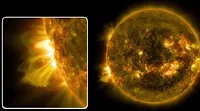A recent NASA study has revealed that massive solar storms stripped Mars of its atmosphere. Now, scientists have issued a warning that we need to do more to be prepared for such a "low probability but high-impact event" striking Earth.
NASA’s Mars Atmosphere and Volatile Evolution (MAVEN) spacecraft, which has been studying the interactions of the Sun and the solar wind with the Mars magnetosphere and upper atmosphere, recently witnessed how a massive solar storm stripped away the planet’s already thin atmosphere, according to the study findings published this week in the journal Science.
“Solar-wind erosion is an important mechanism for atmospheric loss and was important enough to account for significant change in the Martian climate,” noted Joe Grebowsky, MAVEN project scientist.
The so-called “interplanetary coronal mass ejection” caused dramatic spikes in the number of oxygen and carbon dioxide ions spewing into space, the Daily Star Albany reported on Friday.
The March storm was the largest of about a half-dozen similar events that the MAVEN mission has studied since arriving at the Red Planet in September 2014.
The research findings are likely to help scientists explain how Mars evolved from a water-rich, warmer and life-friendly planet into the 'desert-like' planet that it is today.
At the same time, the threat posed by a massive solar storm striking Earth is for real, scientists warn as government agencies including the US Department of Homeland Security and NASA plan the course of action for such an eventuality.
Such space weather events have the capacity to cripple vital technology-based infrastructures, and of causing a cascade that could lead to unforeseeable dangers, gizmag.com reported on Saturday....
[IANS - zeenews.india.com]
9/4/16
--
-
Related:
NASA’s Mars Atmosphere and Volatile Evolution (MAVEN) spacecraft, which has been studying the interactions of the Sun and the solar wind with the Mars magnetosphere and upper atmosphere, recently witnessed how a massive solar storm stripped away the planet’s already thin atmosphere, according to the study findings published this week in the journal Science.
“Solar-wind erosion is an important mechanism for atmospheric loss and was important enough to account for significant change in the Martian climate,” noted Joe Grebowsky, MAVEN project scientist.
The so-called “interplanetary coronal mass ejection” caused dramatic spikes in the number of oxygen and carbon dioxide ions spewing into space, the Daily Star Albany reported on Friday.
The March storm was the largest of about a half-dozen similar events that the MAVEN mission has studied since arriving at the Red Planet in September 2014.
The research findings are likely to help scientists explain how Mars evolved from a water-rich, warmer and life-friendly planet into the 'desert-like' planet that it is today.
At the same time, the threat posed by a massive solar storm striking Earth is for real, scientists warn as government agencies including the US Department of Homeland Security and NASA plan the course of action for such an eventuality.
Such space weather events have the capacity to cripple vital technology-based infrastructures, and of causing a cascade that could lead to unforeseeable dangers, gizmag.com reported on Saturday....
[IANS - zeenews.india.com]
9/4/16
--
-
Related:
- NASA spacecraft seeks answers to lost water in Mars. (Mars Atmosphere and Volatile Evolution/MAVEN)
- NASA to Look at Climate Change - On Mars




No comments:
Post a Comment
Only News